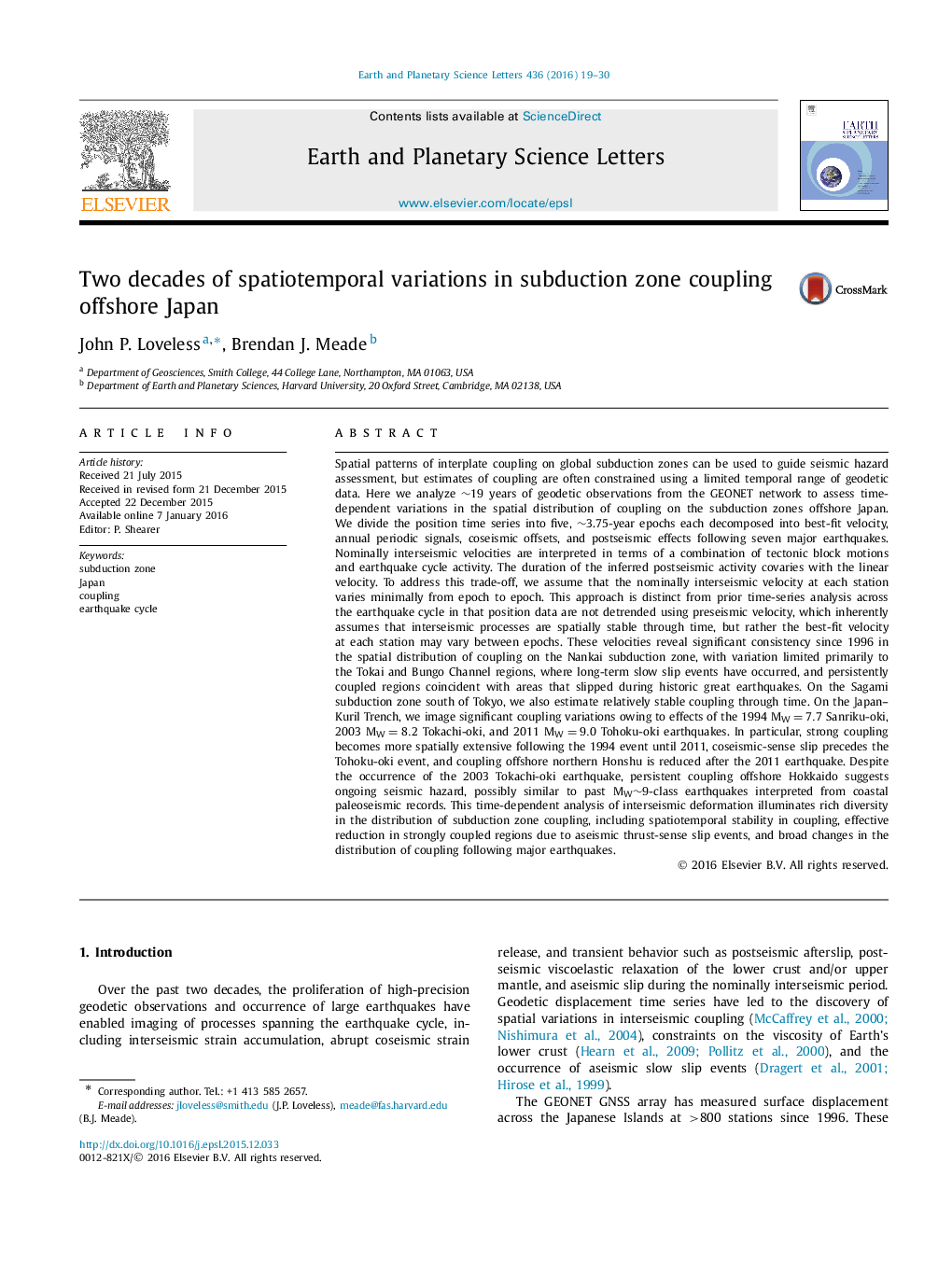| کد مقاله | کد نشریه | سال انتشار | مقاله انگلیسی | نسخه تمام متن |
|---|---|---|---|---|
| 4676948 | 1634720 | 2016 | 12 صفحه PDF | دانلود رایگان |
• We estimate spatiotemporal variation in subduction zone coupling offshore Japan.
• Interseismic and postseismic deformation covary after large earthquakes.
• Strong coupling has been stable since 1996 on Nankai and Sagami subduction zones.
• Great earthquakes on the Japan Trench affect the distribution of coupling.
Spatial patterns of interplate coupling on global subduction zones can be used to guide seismic hazard assessment, but estimates of coupling are often constrained using a limited temporal range of geodetic data. Here we analyze ∼19 years of geodetic observations from the GEONET network to assess time-dependent variations in the spatial distribution of coupling on the subduction zones offshore Japan. We divide the position time series into five, ∼3.75-year epochs each decomposed into best-fit velocity, annual periodic signals, coseismic offsets, and postseismic effects following seven major earthquakes. Nominally interseismic velocities are interpreted in terms of a combination of tectonic block motions and earthquake cycle activity. The duration of the inferred postseismic activity covaries with the linear velocity. To address this trade-off, we assume that the nominally interseismic velocity at each station varies minimally from epoch to epoch. This approach is distinct from prior time-series analysis across the earthquake cycle in that position data are not detrended using preseismic velocity, which inherently assumes that interseismic processes are spatially stable through time, but rather the best-fit velocity at each station may vary between epochs. These velocities reveal significant consistency since 1996 in the spatial distribution of coupling on the Nankai subduction zone, with variation limited primarily to the Tokai and Bungo Channel regions, where long-term slow slip events have occurred, and persistently coupled regions coincident with areas that slipped during historic great earthquakes. On the Sagami subduction zone south of Tokyo, we also estimate relatively stable coupling through time. On the Japan–Kuril Trench, we image significant coupling variations owing to effects of the 1994 MW=7.7MW=7.7 Sanriku-oki, 2003 MW=8.2MW=8.2 Tokachi-oki, and 2011 MW=9.0MW=9.0 Tohoku-oki earthquakes. In particular, strong coupling becomes more spatially extensive following the 1994 event until 2011, coseismic-sense slip precedes the Tohoku-oki event, and coupling offshore northern Honshu is reduced after the 2011 earthquake. Despite the occurrence of the 2003 Tokachi-oki earthquake, persistent coupling offshore Hokkaido suggests ongoing seismic hazard, possibly similar to past MW∼9-classMW∼9-class earthquakes interpreted from coastal paleoseismic records. This time-dependent analysis of interseismic deformation illuminates rich diversity in the distribution of subduction zone coupling, including spatiotemporal stability in coupling, effective reduction in strongly coupled regions due to aseismic thrust-sense slip events, and broad changes in the distribution of coupling following major earthquakes.
Journal: Earth and Planetary Science Letters - Volume 436, 15 February 2016, Pages 19–30
